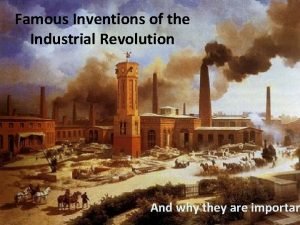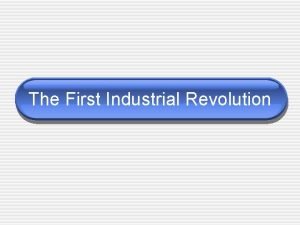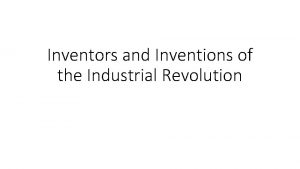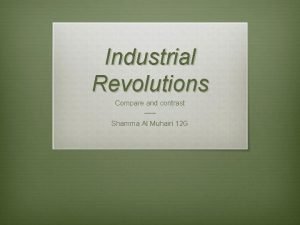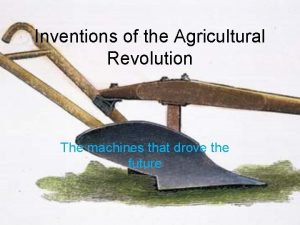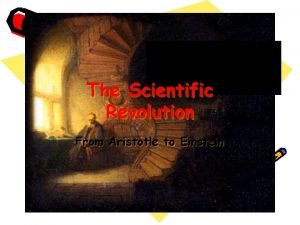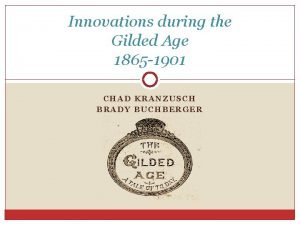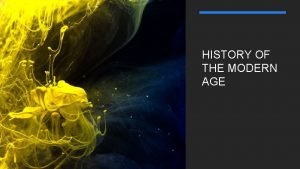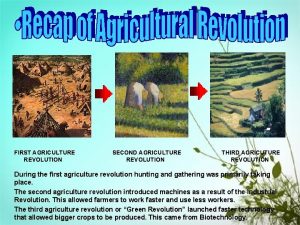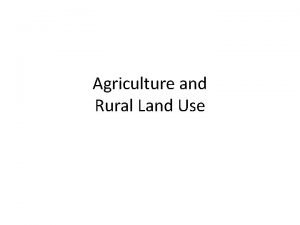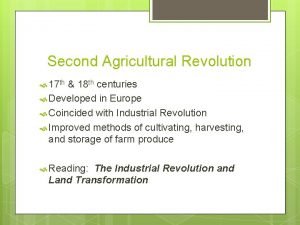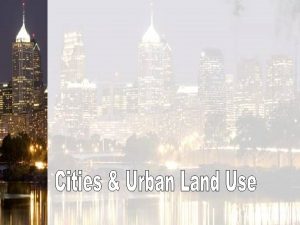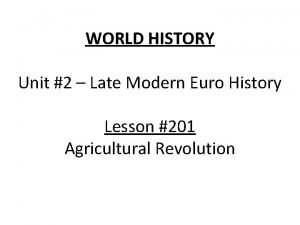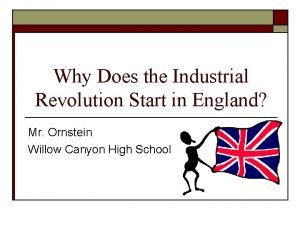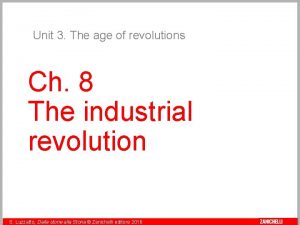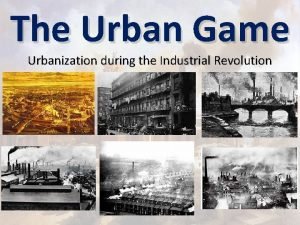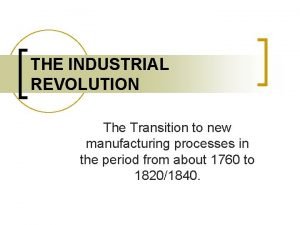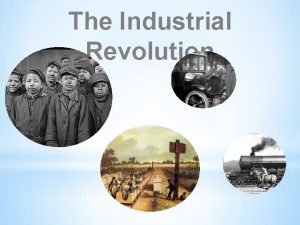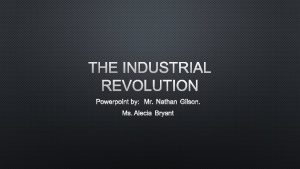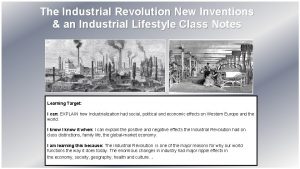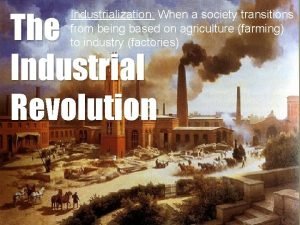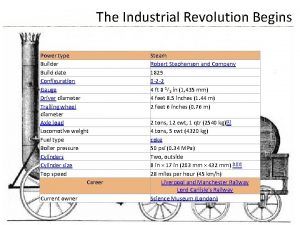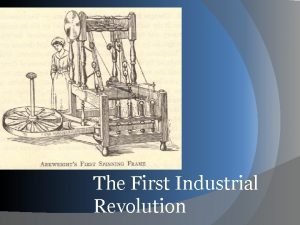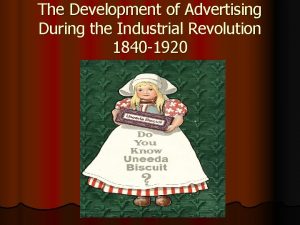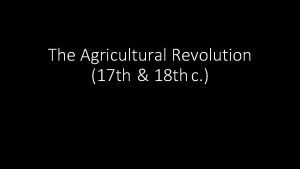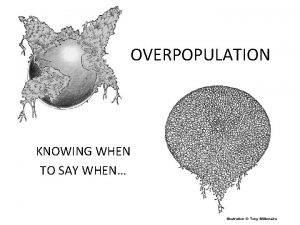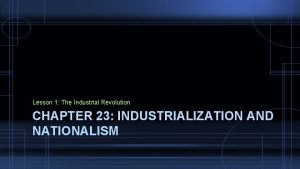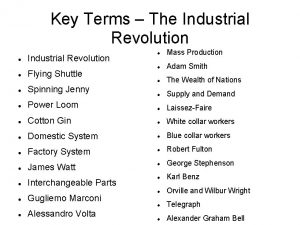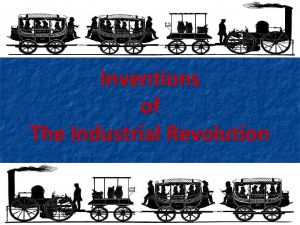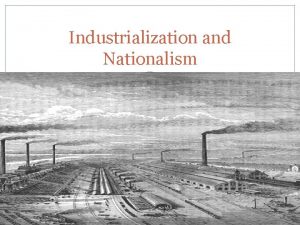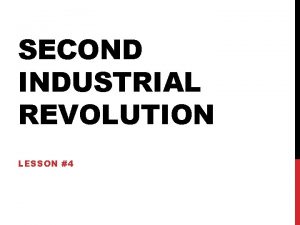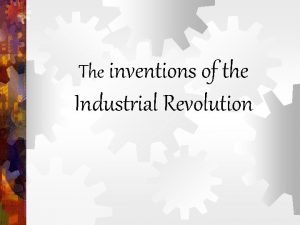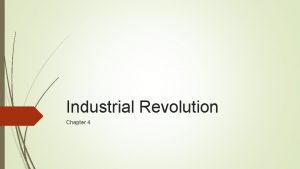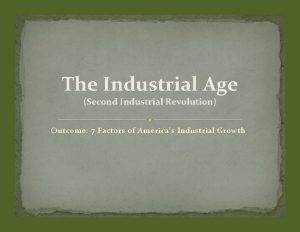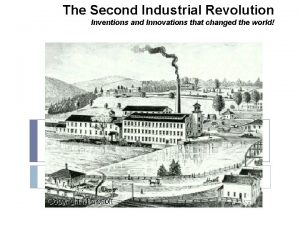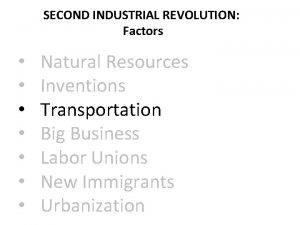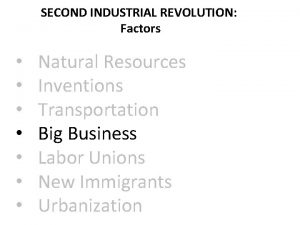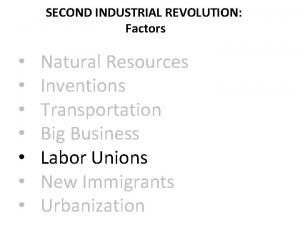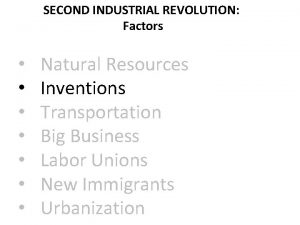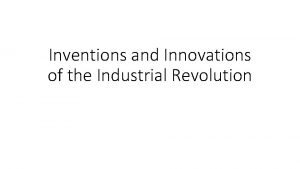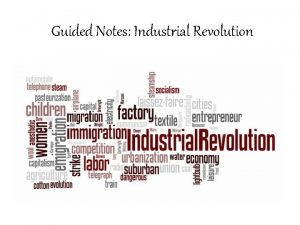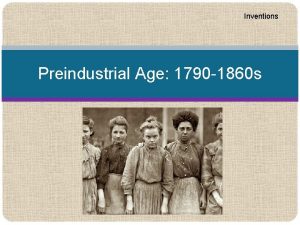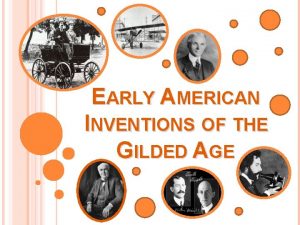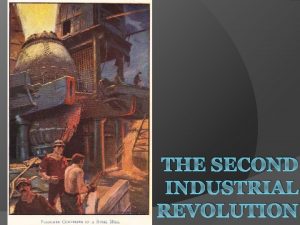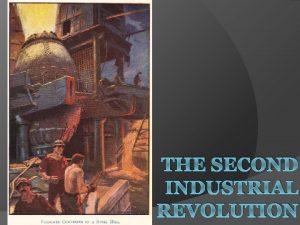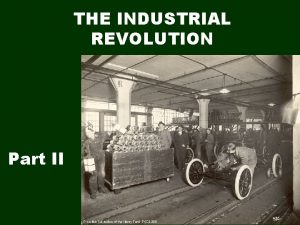Second Industrial Revolution l l Age of Inventions







































- Slides: 39

Second Industrial Revolution l l Age of Inventions Rise of Big Business Labor Unions The Populist Movement

What fueled Industrial Rev? Know All l Abundance of resources. New Inventions Growing urban population that provided markets for products.

Age of Inventions l All inventors received a patent – a guarantee to protect an inventor’s rights to make, use, or sell the invention.

Henry Bessemer l l Bessemer Process – a method of steelmaking that burned off the impurities in molten iron with a blast of hot air. More steel produced in a day. Used steel for cans in storing food, rail lines, skyscrapers, and other buildings.

Oil – used for fuel and light l l Edwin Drake – used steam engine to drill for oil in Titusville, PA. Started oil boom there and more prospectors or “wildcats”. Mc. Coy – invented a lubricating cup that fed oil to parts of a machine while it was running. Helped machines run more smoothly and quickly. Where we get wanting “the Real Mc. Coy”.

Railroads. helped to unite and expand the country. l l l Reliable form of transportation. Rail lines were longer; had been 100 miles. First transcontinental RR – finished when Central Pacific and Union Pacific RR connected at Promonotory, Utah in 1869.

RR continued. . . l l Westinghouse – developed the compressed-air-brake. Double sets of tracks allowed passing of trains. Standard gauge, width of tracks, made rail transportation faster and cheaper. Stimulated urban growth.

Horseless Carriage l l l Had been developed in 1770; used steam engine. Innovations in oil refining led Nikolaus Otto to invent the first internal combustion engine powered by gasoline in 1876. 1893 – Charles and J. Frank Duryea built first practical motorcar in U. S.

Airplanes l l l Orville and Wilbur Wright of Ohio. Used small gasoline engines. Orville made first piloted flight in 1903 in Kitty Hawk, NC – 12 seconds and 120 feet.

Telegraph l l l Developed by Samuel F. B. Morse as a means of communicating over wires with electricity. Led to Western Union. Established offices in train stations and strung telegraph wire on poles alongside RR lines.

Telephone l l l Patented by Bell in March 1876. Businesses found this “talking telegraph” indispensable. Required operators which gave women job opportunities.

Typewriter l l l Developed by Sholes in 1867 for $12, 000 – his partner got over $1 mil in royalties. Sold patent to E. Remington and Sons in 1873 for $12, 000. Gave rise to typing pools, which increased job opportunities for women also.

Edison l l l Advances in electricity, lightbulbs, phonographs, and early motionpicture cameras. Opened workshop in Menlo Park, NJ. Improved Bell’s telephone. l l Held more than 1000 patents when he died. Opened first electric power plants in NYC in 1882 using direct current, DC, electricity. Could only deliver electricity in a small area.

Edison’s Inventions

Transformer l l Westinghouse and Tesla developed a transformer that could transmit highvoltage alternating current, AC, over long distances. Led to electric streetcars.

Big Business l l l Capitalism – economic system that called for private businesses to run most industries; competition determines how much goods cost and workers are paid. Laissez-Faire (473) Free enterprise – belief that economy will prosper if businesses are free of gov’t interference and allowed to compete in free market.

Critics of Free Enterprise l l l Said it was unjust to working class. Karl Marx favored Communism, or no individual ownership. Social Darwinism – society progressed through natural competition. l Means the “fittest” businesses would succeed and the “unfit” would fail. Helping the poor would slow progress.

Corporation owned by stockholders l Advantages l l Raise large sums of money. Stockholders have limited liability. Not dependent on a specific owner for existence. Problems led to. . . l l Trust – group of companies that is controlled by a single group of business leaders Monopolies (475)

Carnegie l l Entered the Steel Industry. Attracted talented people to his company. Success in making better products cheaper. Led to vertical integration (476).

Rockefeller l l l Founder of Standard Oil Company. Also used vertical integration. Expanded by using horizontal integration (477).

Railroad Giants l l Vanderbilt – Pioneer of rail travel. Helped provide a more efficient service. Ran competitors out of business. Pullman – designed and manufactured railroad cars that made long distance rail travel more comfortable.

Mass Marketing l l How? - Brand names, packaging, and advertising Mail-order companies like Montgomery Ward and Sears and Roebuck sold variety of goods through catalogs. Department stores catered to demands of urban market. (Macy’s) Chain stores (Woolworths)

Government and Business l l Sherman Antitrust Act – outlawed all monopolies and trusts that restrained trade. 10% of population controlled 75% of the wealth!

New Working Class l Most jobs were filled by immigrants. l Nearly all textile workers were native born whites. African Am got few jobs and/or the worst jobs. l l Female workers doubled b/w 1870 -1890. l 20% of Am children 10 -15 worked for wages.

Working Conditions – l l Long hours, low pay More difficult for unskilled workers. Little effort was made to improve conditions and safety. Employers even controlled life outside of work.

Knights of Labor l l Led by Powderly Attract both skilled and unskilled workers, and those excluded from other unions. Opposed Chinese workers. , but included blacks and women. Fought for temperance, 8 hour day, equal pay for equal work, and end child labor.

Great Upheaval l l 1886 – intense year of strikes and violent labor confrontations. Examples. . .

Haymarket Riot l Most violent of all strikes. l Peaceful at start until police arrived and bomb exploded. Led to vocal opponents of Knights of Labor. l

Yellow-dog contracts l l Signed by workers promising not join unions. Workers still went on strike. Public supported employers b/c of violence of strikes.

AFL l l Founded by Samuel Gompers. Organized independent craft unions into a group that worked to advance the interests of skilled workers.

Homestead Strike l In 1892 at Carnegie Steel over a wage cut. l 16 people killed when workers were locked out and strikers shot at and killed replacements. State militia called out to help management. Plant reopened with non-union workers and larger pay cut. Some strikers were blacklisted. l l

Pullman Strike l l l Pullman cut wages, but did not lower rent or prices. Government ordered the strike to end b/c it prevented to delivery of mail. President had to call in troops.

Farmers’ Problem(s) l l l Had to plant more crops and raise more animals for growing population, but prices fell as supply exceeded demand. Profits dropped – could not repay loans/lost farms. Losing money.

National Grange l l l Farmers organized to improve situation. Founded by Oliver Kelly to tackle economic and political issues. Main focus – forcing states to regulate railroad freight and grain storage rates.

Interstate Commerce Act l Prohibited railroads from giving secret rebates to large shippers or charging more for short hauls than long hauls.

Farmer Alliance l Organized cooperatives to buy equipment and to market farm products, lobbied for tougher bank regulations, graduated income tax.

Money Question l l l Alliance Movement favored printing greenbacks. 1873 – Congress went away from silver to gold to limit money supply. Farmers wanted silver, but did not get it.

Populist Party l Founded by Alliance members, farmers, labor leaders, and reformers. l Platform (3) – graduated income tax, bank regulation, gov’t ownership of RR, coinage of silver, shorter workday, immigration restrictions.

Election of 1896 l Mc. Kinley (R) defeats Bryan (D). l Populist supported Bryan. l Election and improvements of farmers brought an end to Populist Party.
 Famous inventions of the industrial revolution
Famous inventions of the industrial revolution Interchangeable parts
Interchangeable parts Bessemer process
Bessemer process 2nd industrial revolution timeline
2nd industrial revolution timeline First and second industrial revolution
First and second industrial revolution Agricultural revolution inventions
Agricultural revolution inventions Scientific revolution inventions
Scientific revolution inventions Stone age, bronze age iron age timeline
Stone age, bronze age iron age timeline Iron age bronze age stone age timeline
Iron age bronze age stone age timeline Gilded age inventions
Gilded age inventions Modern age inventions
Modern age inventions 186 282 miles per second into meters per second
186 282 miles per second into meters per second The second agricultural revolution
The second agricultural revolution The second agricultural revolution
The second agricultural revolution Second urban revolution ap human geography
Second urban revolution ap human geography The second agricultural revolution coincided with
The second agricultural revolution coincided with Borchert's epoch definition
Borchert's epoch definition Russian revolution vs french revolution
Russian revolution vs french revolution How could the french revolution been avoided
How could the french revolution been avoided Definition of third agricultural revolution
Definition of third agricultural revolution How changed
How changed Why did the industrial revolution start in britain
Why did the industrial revolution start in britain Industrial revolution zanichelli
Industrial revolution zanichelli Urbanization board game
Urbanization board game Enclosure movement industrial revolution
Enclosure movement industrial revolution When was the loom invented
When was the loom invented The transition to new manufacturing processes
The transition to new manufacturing processes Industrial revolution quiz
Industrial revolution quiz Nathan gilson
Nathan gilson Industrial lifestyle
Industrial lifestyle The effects of the industrial revolution meme
The effects of the industrial revolution meme Multistory building divided into crowded apartments
Multistory building divided into crowded apartments 1st industrial revolution
1st industrial revolution Ads during the industrial revolution
Ads during the industrial revolution Enclosure movement
Enclosure movement Thomas malthus industrial revolution
Thomas malthus industrial revolution Chapter 23 lesson 1 the industrial revolution
Chapter 23 lesson 1 the industrial revolution How did the flying shuttle change the world
How did the flying shuttle change the world Phonograph industrial revolution
Phonograph industrial revolution Chapter 10 lesson 1 the industrial revolution
Chapter 10 lesson 1 the industrial revolution
